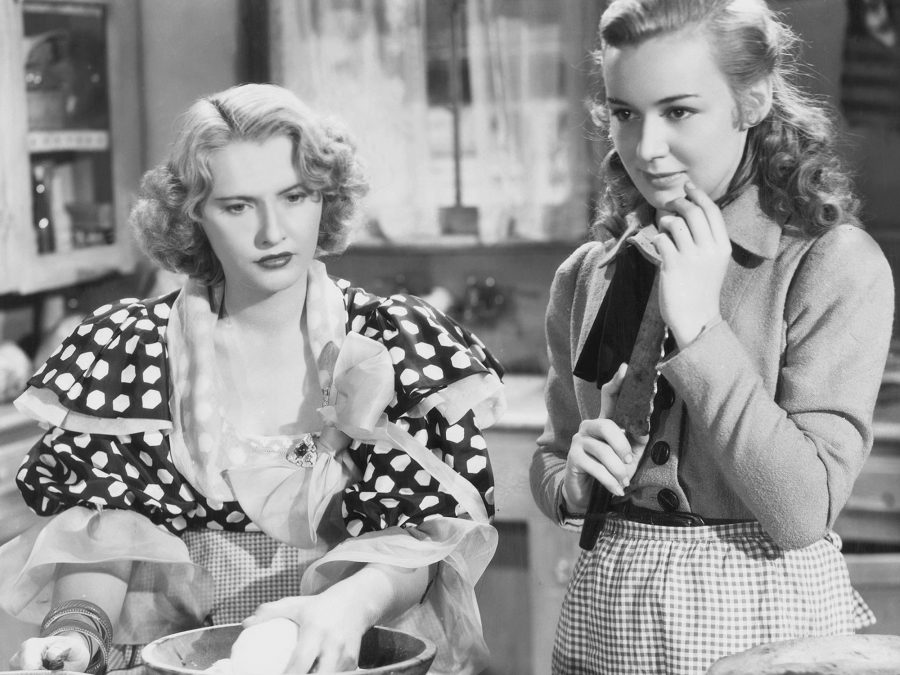S[/stopcap]tella Dallas opens with a brief series of shots in which the titular character (née Martin) exits her front door at the sight of workers returning home, tidies the ruffled collar of her blouse, smooths her hair, and poses while reading a carefully selected collection of poetry on her front lawn. Though several men carrying lunch boxes greet Stella, she pays them no attention; the object of her affections is Stephen Dallas (John Boles), a wealthy executive of the town mill. When he approaches her fence to light a cigarette, she feigns disinterest, but her facade is instantly dropped when she lowers the book to intently observe him as he continues strolling. This calculated exchange, involving the strategic presentation of her body, sets in motion her plan to become upwardly mobile.
Eventually, Stella seduces Stephen with a staged encounter that positions her as a desirable domestic partner, enters a marriage with the moneyed man, and gives birth to their daughter Laurel. However, Stella’s class differences become apparent through her increasingly flamboyant outfits and their relationship dissolves as quickly as it began, with Laurel caught in the middle. Realising that her transgressions have caused Laurel to become a subject of ridicule, Stella officially severs ties to her family and relinquishes a relationship with her daughter in order to secure Laurel’s successful integration into high society.
Released in 1937, King Vidor’s Stella Dallas was a remake of the 1925 silent film also produced by Samuel Goldwyn and adapted from Olive Higgins Prouty’s novel of the same name. Barbara Stanwyck and Anne Shirley – who played Laurel – earned Academy Award nominations for Best Actress and Best Supporting Actress for their enduring performances, firmly cementing the film as a maternal melodrama. Given its devastating conclusion – Stella tearfully watches her daughter’s wedding through a window in the rain while a police officer escorts her away – it’s no surprise that the film is frequently cited as an example of a “weepie” that exemplifies the helpless, sacrificial mother.
Fortunately, not all is lost for our sartorially adventurous protagonist. When Stella’s resourcefulness is foregrounded, the possibility of a resistant reading emerges, and her failure to assimilate into her husband’s life becomes a refusal. She dutifully performs as a refined woman who is eager to please until her wealth is firmly secured with a marriage contract and a child, and subsequently casts the role aside to furnish a maximalist wardrobe filled with prints and decorative elements through her newfound resources. Along a line of thinking that grants agency to Stella, her flagrant disregard for dress codes works to destabilise both traditional looking relations and the social stratification maintained by fashion.
One explicit instance of her refusal takes place after attending a ball, where Stella returns home wearing jewellery that she seemingly removed at Stephen’s request. When he displays contempt for “those earrings, that cheap imitation necklace,” she snaps back to assert her own authority over the realm of fashion: “I’ve always been known to have stacks of style.” Coupled with the opening scene, this early display of defiance exemplifying her unyielding nature establishes Stella as a woman who is devoted to the expression of personal style above companionship.
Of course, Stephen’s descriptor “cheap” is also saturated with classism. As an instrument of the upper class, where mannerisms and unwritten rules of taste are passed down from generation to generation, he’s invested in enforcing social hierarchy in addition to patriarchy. There’s an expectation for Stella to abandon her working-class patterns of consumption and adornment, to dress in a manner that subtly alludes to their wealth through a restrained approach that is free of visual excess.

It’s an aesthetic that calls to mind architect Adolf Loos’ “Ornament and Crime,” which argued against ornamentation in all creative arts for its impracticality and wastefulness. Published in 1918, the essay challenged the popularity of decoration at the end of the 19th century, particularly Art Nouveau, and similarly grounds his criticism in class politics. For Loos, ornamentation was the sole manner of achieving purpose and happiness for the working class, whereas the ruling class, with its sophisticated taste and other joys, had no need for frivolity or displays of power. Extending his utilitarian beliefs to fashion, he cites silk, satin, lace and velvet – all fabrics cherished by Stella – as belonging to individuals who were uncultivated and primitive.
Against the dismissal of ornamentation in the 20th century, Stella’s unabashed love of frills and ribbons assaults the sensibilities of Stephen and his peers. She poses as a threat who must be neutralised through ostracism so that she acquiesces to their uninspired tastes or removes herself from high society. Faithful to her convictions, Stella ultimately chooses the latter, preferring to wield fashion as a mechanism to pursue pleasure above reputation or shallow approval. After all, a long plaid jacket will provide more warmth than her husband, and a polka-dotted dress with bows and tiered ruffles is destined to outlive their marriage.
Though the ending remains gut-wrenching for Stella as a mother, she stands victorious as a style icon who defied dress codes and contested the goal of minimising one’s presence through clothes that flatter, cinch and restrict the body. Her enormous gowns that occupy space within the frame compel us to look, but are unmoved by our judgements.
Wrapped in a fox shawl and topped with a veiled hat, she confidently stomps the grounds of the country club in a multi-layered outfit that guests liken to a Christmas tree, but she prefers the company of clothes to people anyway. In the final scene, her garments reciprocate her devotion and arrive at her defence at last: the structured, fur-collared tweed coat and wide-brimmed hat serve as armour, protecting her against the elements and a society unforgiving to sartorial visionaries.
The post Eighty-five years on, Stella Dallas remains a style icon appeared first on Little White Lies.


0 Comments